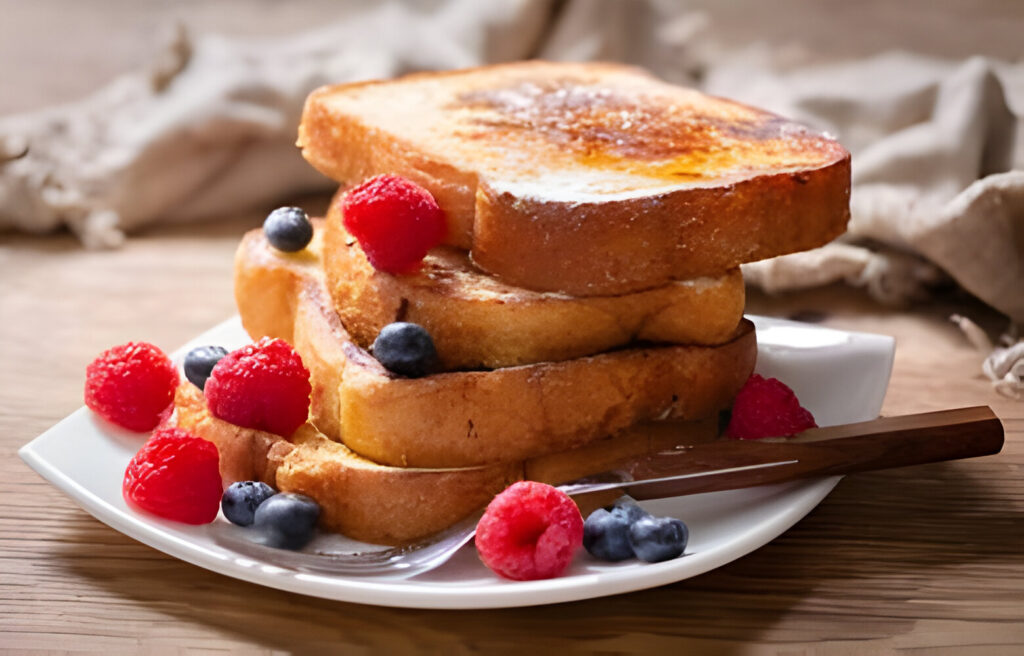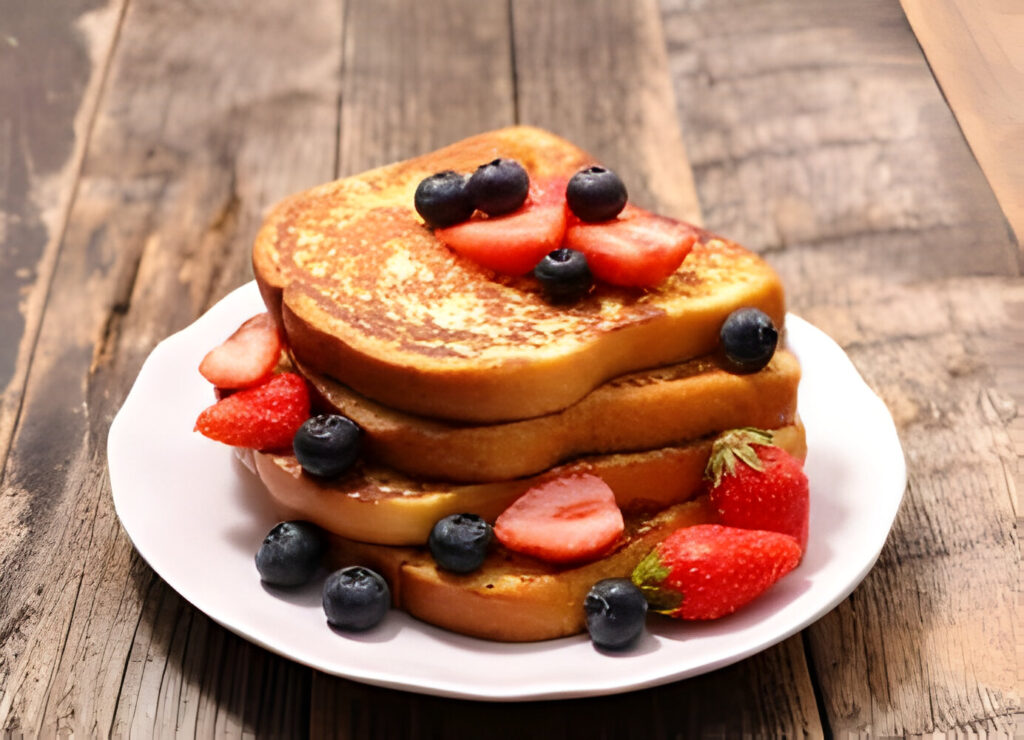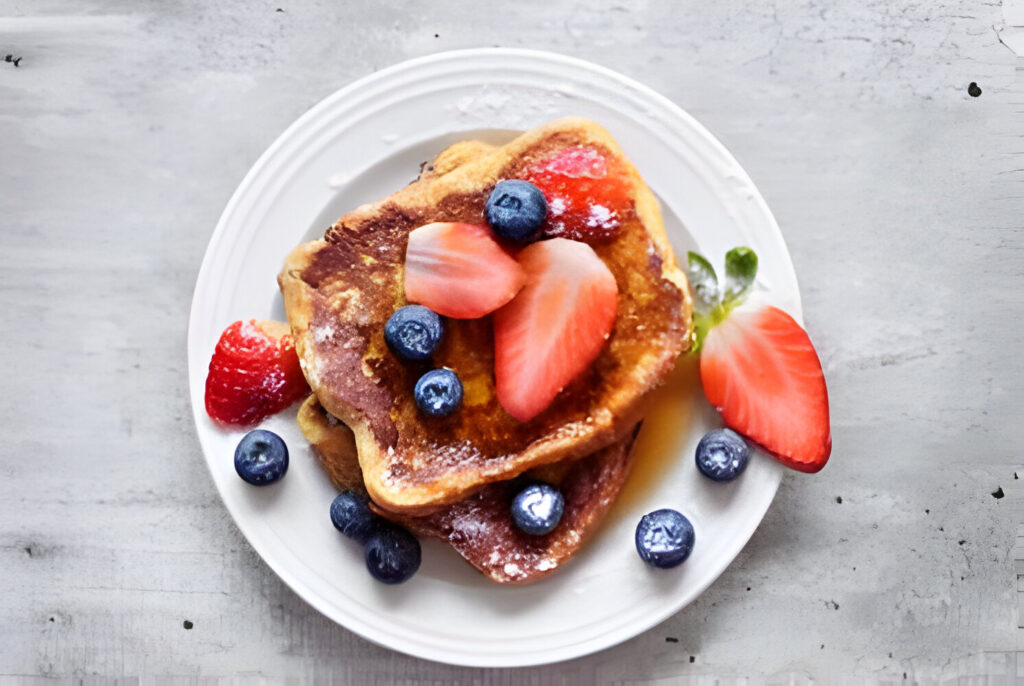
Understanding the Basics of French Toast
Creating the perfect French toast starts with understanding its basic components. This section delves into the essential ingredients and tools you’ll need. By focusing on these foundations, you’ll be ready to explore various recipes and techniques.
Ingredients Overview
Bread Selection: The heart of any French toast recipe is the bread. While traditional recipes call for brioche or challah due to their rich texture and buttery flavor, don’t hesitate to experiment with whole wheat, French baguette, or artisanal breads for a unique twist. Aim for bread that’s 1 to 2 days old, as slightly stale bread soaks up the batter better without falling apart.
Eggs and Milk: Eggs and milk form the base of your batter, creating a custard-like mixture that gives French toast its iconic taste and texture. For a richer batter, consider using half-and-half or heavy cream instead of milk. Incorporating eggs ensures your French toast has a tender, custard interior, essential for that mouthwatering experience.
Sweeteners and Flavorings: Vanilla extract and cinnamon are popular choices for adding depth to the batter’s flavor. Don’t shy away from experimenting with nutmeg, cardamom, or even citrus zest to elevate the dish. A touch of sugar in the batter can help in caramelizing the bread’s exterior, offering a delightful contrast between the soft interior and the crispy, golden-brown crust.
Tools and Equipment Needed
Skillet or Griddle: A non-stick skillet or griddle is key for cooking French toast evenly. It allows for easy flipping and ensures your bread doesn’t stick, maintaining its integrity and texture.
Spatula: A wide, flat spatula is indispensable for flipping French toast. It provides support, preventing the bread from breaking apart during the cooking process.
Mixing Bowls: You’ll need at least one large mixing bowl for the batter. Whisking the eggs, milk, and flavorings together thoroughly ensures a smooth, homogenous mixture.
Measuring Tools: Accurate measurements contribute to the consistency and success of your French toast. Use measuring cups and spoons for the ingredients to achieve the perfect balance of flavors every time.
Bread Knife: A serrated bread knife is ideal for slicing bread to your desired thickness. Thicker slices are more forgiving when soaked in batter and offer a satisfying texture.
Final Thoughts
Equipping yourself with the right ingredients and tools is the first step towards mastering French toast. By understanding these basics, you can start to experiment with different bread types, batter mixtures, and cooking techniques. Remember, the best French toast balances a crispy exterior with a soft, custard-like interior, achieved through careful selection of ingredients and the right cooking equipment.
The Perfect French Toast Batter
A pivotal element in crafting the perfect French toast is the batter. It’s this simple yet crucial mixture that soaks into the bread, giving French toast its distinctive, custardy interior. In this section, we’ll explore how to make the ideal batter and offer variations to suit different dietary needs.
Crafting the Batter
Start with the Basics: At its core, French toast batter consists of eggs and milk. For every 4 slices of bread, whisk together 2 large eggs and ½ cup of milk. This ratio ensures the bread is adequately soaked without becoming too soggy. For a richer taste, substitute milk with half-and-half or a blend of milk and cream.
Flavoring Your Batter: Vanilla extract and ground cinnamon are traditional favorites for infusing the batter with warmth and depth. Start with a teaspoon of vanilla and a quarter teaspoon of cinnamon for the basic mixture. However, the beauty of French toast lies in its versatility. Feel free to add a dash of nutmeg or cardamom, or even some orange zest for a citrusy twist. Sweeteners like sugar or maple syrup can also be mixed into the batter, aiding in caramelization and adding a subtle sweetness.
Consistency is Key: The batter should be whisked until smooth, with no streaks of egg. A homogeneous mixture ensures each slice of bread is evenly coated, resulting in a consistent texture throughout.
Accommodating Dietary Restrictions
Dairy-Free Options: For those avoiding dairy, almond milk, coconut milk, or soy milk make excellent substitutes. These alternatives maintain the batter’s richness while offering a unique flavor profile.
Vegan Variations: Creating a vegan French toast batter is simpler than it might seem. Replace eggs with a mixture of mashed bananas or applesauce and a splash of plant-based milk. For binding, add a tablespoon of ground flaxseed or chia seeds. This not only replicates the texture of traditional French toast but also introduces additional nutrients.
Gluten-Free Guidance: Opt for gluten-free bread and ensure that your other ingredients are free from cross-contamination. The batter recipe remains the same, allowing everyone to enjoy this classic dish without concern.
Final Thoughts
Mastering the French toast batter opens a world of breakfast possibilities. By starting with the basic formula and understanding how to adjust for different tastes and dietary needs, you’re well on your way to creating mouthwatering variations. Experimentation is encouraged; after all, the best part of cooking is making a dish your own. Remember, the goal is a batter that complements the bread, creating a harmonious balance of flavors and textures. With these tips, you’re equipped to achieve just that.

Mastering the Cooking Technique
Achieving the perfect French toast goes beyond just the batter; it’s also about mastering the cooking technique. This section will guide you through the crucial steps and tips to ensure your French toast is cooked to perfection, boasting a crispy exterior with a soft, custardy center.
Cooking Temperature and Time
Finding the Sweet Spot: Cooking French toast requires medium heat. Too high, and the outside burns before the inside cooks; too low, and the bread becomes soggy. Aim for a temperature around 350°F (175°C) if you’re using an electric griddle, or set your stove to medium.
Patience Pays Off: Each side of the French toast should cook for about 3 to 4 minutes. Look for a golden-brown crust as your cue to flip. Resist the urge to press down on the bread with your spatula; this can squeeze out the custardy interior.
Achieving the Perfect Texture
Bread Thickness Matters: Slice your bread about ¾ to 1 inch thick. Thicker slices provide a robust base for the batter, resulting in a soft interior without falling apart.
Batter Soaking Time: Dip each slice into the batter for about 20 to 30 seconds per side. This time allows the bread to soak up the batter without becoming overly soggy. Gently shake off excess batter before placing the bread on the skillet.
Use the Right Pan: A non-stick skillet or griddle is best for cooking French toast. It reduces the need for excessive butter or oil and ensures the bread doesn’t stick, preserving its texture and shape.
Finishing Touches: For extra thick slices or to ensure the middle is cooked through, finish your French toast in a preheated 375°F (190°C) oven for a few minutes. This step is optional but can make a difference, especially when serving multiple people at once.
Final Thoughts
Cooking French toast to perfection is an art that combines the right ingredients, batter consistency, and cooking technique. By paying attention to the temperature, cooking time, and bread preparation, you’ll unlock the secret to making French toast that’s crispy on the outside and custardy on the inside. Remember, practice makes perfect. Don’t be afraid to experiment with different heat settings, bread types, and soaking times to find what works best for you. With these tips, you’re well on your way to mastering the art of French toast, ready to impress at your next brunch or breakfast gathering.
Creative French Toast Variations
French toast serves as a blank canvas for culinary creativity, allowing both sweet and savory lovers to indulge in their preferences. This section explores a range of recipes, adding a twist to the classic breakfast dish by incorporating unique ingredients and flavors.
Savory Options
Cheese and Herb French Toast: Elevate your breakfast by adding grated cheese and fresh herbs into the egg batter. Choose herbs like chives, parsley, or thyme for a fragrant touch. Cook as usual and top with a dollop of sour cream or a sprinkle of additional herbs for a gourmet twist. This variation pairs wonderfully with a side of crispy bacon or smoked salmon, appealing to those who prefer a savory start to their day.
Avocado and Tomato French Toast: For a healthier take, spread ripe avocado on your cooked French toast slices. Add sliced tomato, a drizzle of olive oil, and a sprinkle of salt and pepper. The creamy avocado and the juicy tomato offer a refreshing contrast to the rich, custard-soaked bread, creating a balanced and nutritious dish.
Sweet Delights
Chocolate and Banana Stuffed French Toast: Satisfy your sweet tooth by spreading a thin layer of chocolate hazelnut spread between two slices of bread before dipping them in the batter. Cook until golden brown and serve with sliced bananas and a dusting of powdered sugar. The combination of warm chocolate and sweet bananas makes for a decadent breakfast or dessert.
Berry and Cream Cheese French Toast: Before soaking your bread in the batter, spread a layer of cream cheese and your favorite berry jam between two slices. The tangy cream cheese and sweet jam complement the custardy bread, while fresh berries on top add a burst of freshness. This version is perfect for brunch gatherings, offering a delightful mix of flavors and textures.
Global Twists
French Toast Roll-Ups: Inspired by sushi, spread fillings like cream cheese and strawberries on bread slices, then roll them up before dipping in the batter and cooking. Slice into bite-sized pieces and serve with syrup for dipping. This fun and interactive variation is great for kids and adults alike.
Masala French Toast: Incorporate the flavors of India by adding spices such as turmeric, garam masala, and finely chopped green chili to the egg batter. Serve with a side of tangy mint chutney for a savory French toast that packs a punch.
Final Thoughts
Experimenting with French toast variations can turn a simple breakfast into an exciting culinary adventure. Whether you’re in the mood for something sweet, savory, or internationally inspired, there’s a French toast recipe out there for you. Don’t be afraid to get creative with fillings, toppings, and spices to discover your next favorite breakfast dish. With these ideas as a starting point, the possibilities are endless.

Serving and Presentation Tips for French Toast
The presentation of French toast can significantly enhance the dining experience, making a simple breakfast feel like a luxurious brunch. This section provides tips on serving and presenting French toast in ways that are both visually appealing and delicious.
Accompaniments and Toppings
Fruit Toppings: Fresh fruits such as berries, sliced bananas, and peaches add color and a natural sweetness to French toast. Arrange the fruits on top or alongside the dish for a vibrant presentation. For an extra layer of flavor, consider simmering fruits with a bit of sugar to create a warm, syrupy compote.
Syrups and Sauces: Maple syrup is a classic choice, but don’t limit yourself. Experiment with honey, agave syrup, or homemade caramel for variety. Chocolate sauce or fruit coulis can also elevate the dish, providing a gourmet touch.
Whipped Cream and Nuts: A dollop of whipped cream adds a luxurious texture, while a sprinkle of chopped nuts (such as almonds, walnuts, or pecans) introduces a satisfying crunch. These toppings offer a contrast in textures that enhances the overall mouthfeel of the dish.
Plating Techniques
Layering: Instead of serving individual slices, stack French toast slices to create height on the plate. Alternate layers with thinly spread fillings like cream cheese or chocolate spread for a surprise in every bite.
Dusting and Drizzling: A light dusting of powdered sugar or cocoa powder can make your French toast look irresistible. Drizzle syrups or sauces in a zigzag or spiral pattern for a professional finish.
Garnishes: A sprig of fresh mint or a few edible flowers can add a sophisticated touch to your presentation. These simple additions show attention to detail and elevate the visual appeal.
Final Thoughts
The way is served can transform it from a mere meal to a memorable experience. By focusing on the accompaniments, toppings, and plating techniques, you can turn this classic dish into a feast for the eyes and the palate. Remember, the goal is not just to satisfy hunger but to delight the senses. With these tips.
Conclusion and Call to Action
After exploring the various facets of creating the perfect French toast, from selecting the right ingredients to mastering the art of presentation, it’s clear that this beloved dish offers a canvas for culinary creativity. This journey through French toast preparation demonstrates that with a few basic techniques and a dash of imagination, anyone can elevate their breakfast game.
Embrace Experimentation
French toast, in its essence, is about transformation—turning simple, everyday ingredients into a meal that can start the day on a high note or even round off a special brunch. The versatility we’ve uncovered in bread choices, batter mixtures, cooking methods, and toppings serves as a testament to the endless possibilities that French toast presents. So, we encourage you to embrace experimentation. Whether tweaking the batter to suit dietary preferences or inventing a new topping combination.
Share Your Creations
We invite you to share your French toast adventures. Whether it’s a family recipe passed down through generations or a brand-new creation sparked by inspiration from this guide, your experiences can inspire and encourage others to explore the culinary possibilities of French toast. Use social media platforms, food forums, or personal blogs to showcase your creations. Include photos, tips, and any lessons learned along the way. By sharing, you become part of a community that celebrates not just food, but the joy of cooking and creativity.
Final Thoughts
Remember, the perfect French toast is not just about following a recipe to the letter—it’s about making it your own. Whether you stick to the classic or venture into new culinary territories, the most important ingredient is the love and care you put into your cooking. So, grab your spatula, and let’s make every breakfast a little bit more delicious.
Call to Action
Now, it’s your turn to take these tips and tricks into your kitchen. Experiment with the recipes and techniques we’ve discussed, and don’t forget to share your masterpieces with the world. We can’t wait to see what delicious variations you come up with. Happy cooking!
More Articles Like this :